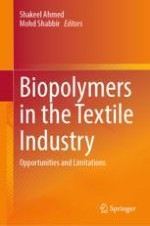Abstract
Wool, silk, and cashmere are natural fibers, proteins which are developed of condensed alpha-amino acids found in animal sources. They possess unique characteristics, including warmth, moisture-wicking ability, and resilience. Wool, a widely used protein fiber, is synthesized from keratin produced by specialized cells in sheep's skin. The wool life cycle involves shearing, cleaning, spinning, and manufacturing into various products like clothing, blankets, and upholstery. The chemical composition of wool includes keratin, which gives it its distinctive properties. Wool finds applications in clothing, home textiles, outdoor gear, filtration, insulation, and various industrial sectors. Protein fibers, such as collagen and silk, have diverse medical applications. They are commonly used in wound dressings, tissue engineering scaffolds, and controlled drug delivery systems. Protein fibers offer unique properties, including biocompatibility, biodegradability, and mechanical strength, making them valuable in the development of artificial organs and surgical materials. Additionally, these fibers have potential applications in bioadhesives for tissue sealing and wound closure. As research continues, exploring the full potential of protein fibers from various sources may lead to innovative advancements in medical technology and therapeutics.
